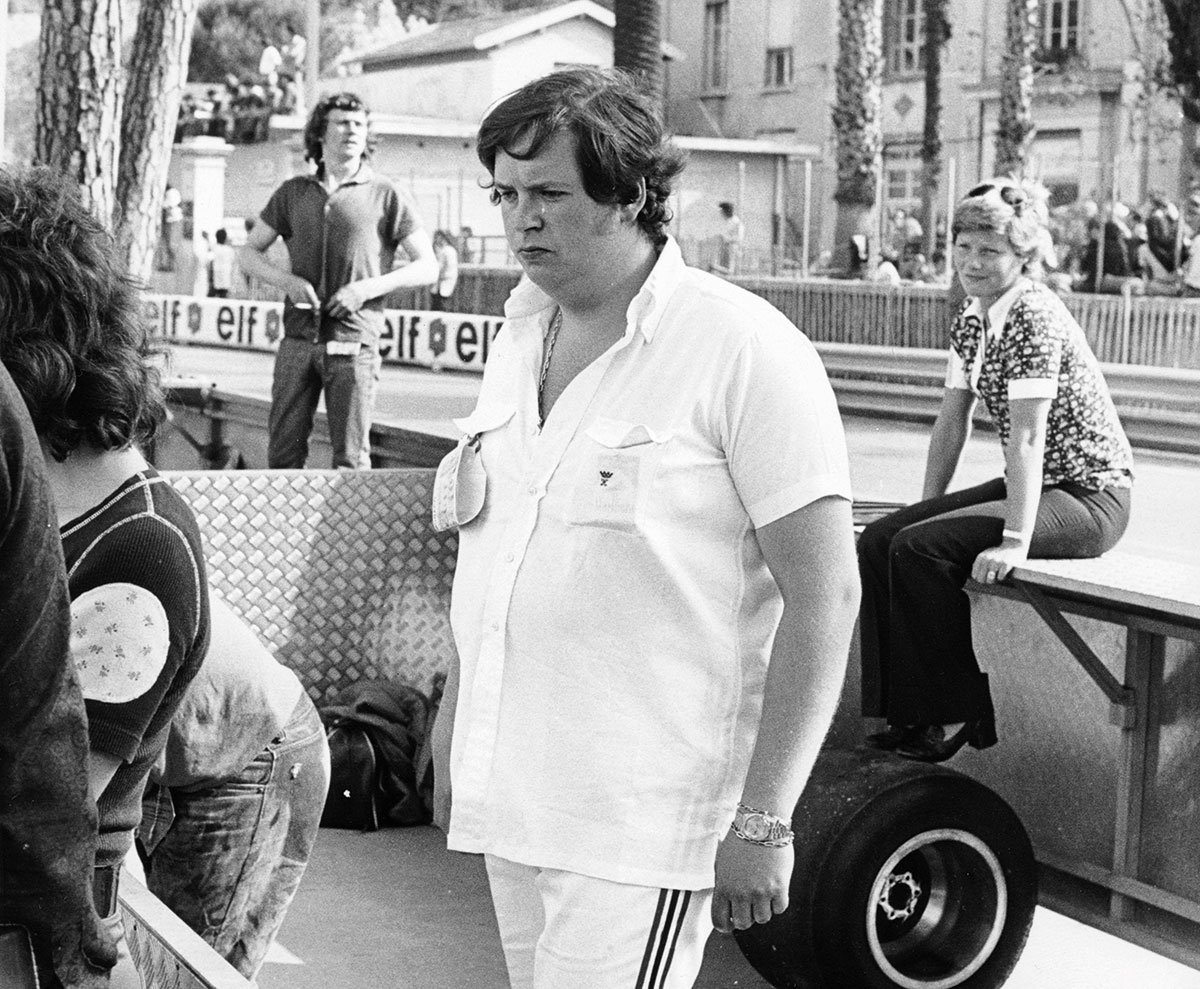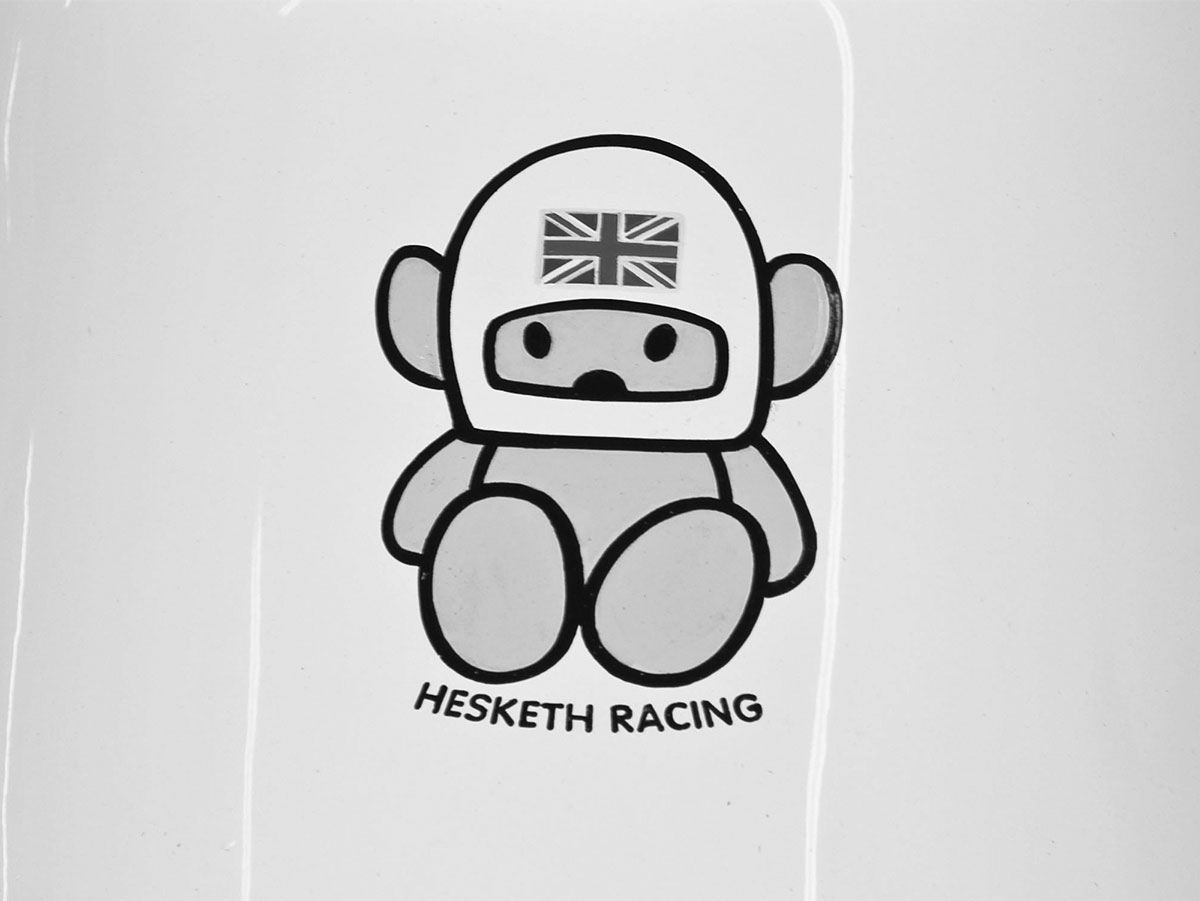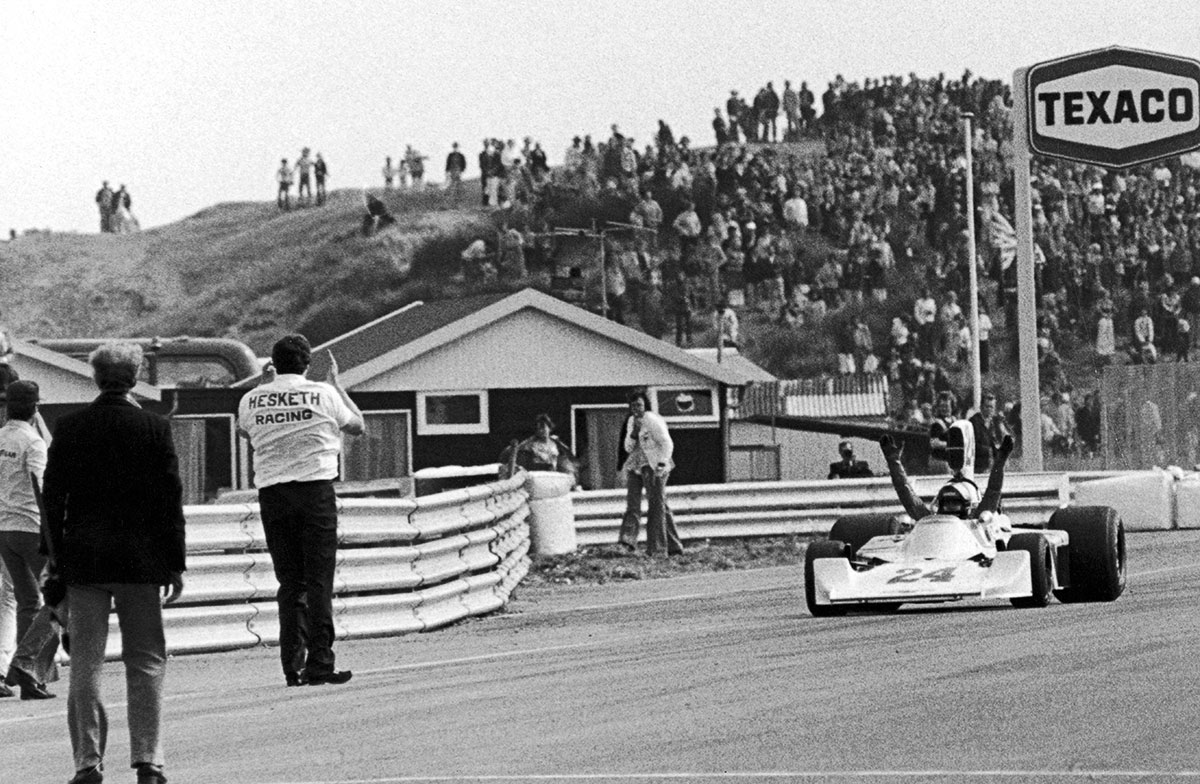
FOR THE HELL OF IT
Until the 2013 movie Rush many of F1’s new generation of enthusiasts had probably never heard of Hesketh Racing. But for those who love a story of triumph over adversity and fun before conformity Hesketh provides the perfect template, and proof that once upon a time in F1 anything was possible.
Lord Thomas Alexander Fermor-Hesketh was born into one of the richest families in England. Following the premature death of his father in 1955 Hesketh aged just five, became the third Baron Hesketh. Educated at Ampleforth, Hesketh then travelled to San Francisco for a stint as a trader in the stock market before returning to England to run the family business.
Most motor racing teams are born from engineering expertise or automotive heritage and not from a doodle on a postcard, unless you are an eighteen year old Lord looking for something to play with. But the crash helmet and Union Jack which Lord Hesketh doodled onto the teddy bear that featured on a postcard he had received, became the inspiration behind a new team.
The newly formed Hesketh Dastle team entered Formula 3 in 1972. Hesketh and his best friend Anthony ‘Bubbles’ Horsley joined with the intention of partying around the world whilst doing a bit of racing. Bubbles had been in and around the sport for several years and was the team’s only driver. Although no great shakes behind the wheel Bubbles was, to say the least, a resourceful character who earned his living through a variety of revenue streams including acting in TV commercials.
The Hunt is on board
More often than not Bubbles would crash the car either in practise or during the race and eventually both men agreed that for the team to progress they had to find another driver. At Bubbles’ suggestion they approached a driver who was known to them, a driver whose career seemed to be going nowhere and who, like Bubbles, had a reputation for writing off cars, his name was James Hunt. With nothing to lose Hunt was soon on board.
Several weeks later during the F3 British Grand Prix at Brands Hatch the story of Hesketh Dastle came to an abrupt end, Bubbles crashed his car during practise and Hunt wrote his car off during the race. Hunt was by no means finished and approached the then March team director Max Mosley for the loan of an old F2 March chassis, Mosley obliged. Hunt’s prayer to the “Good Lord” – Hesketh was answered with the funds to purchase a Ford DBA engine. The team were back in business only now as an F2 outfit. At this point Bubbles decided to quit driving and instead manage the team.
Having failed in F3, remarkably the team prospered better in F2. Hunt finished in the points twice even taking a creditable third place at Oulton Park vying for the lead with the March cars of Ronnie Peterson and Niki Lauda. This reversal of fortune convinced Hesketh to mount a full-scale assault on the 1973 European F2 Championship with a new car a Surtees TS15.
Le Patron, Superstar, Bubbles and The Doc
But no sooner had the chequered flag been waved in the first race at Mallory Park and the team had a problem. Although Hunt was fastest of the Ford powered cars he was so far behind the March BMW cars it was obvious a season-long struggle lay ahead. Hesketh’s solution was typical; if the team weren’t going to win in F2 then they would try in F1!
After another visit to Max Mosley the team took delivery of a new car, a Cosworth DFV powered March 731. Hesketh now had an F1 car but nobody in the team had the required know-how to develop it. Moseley unwittingly supplied this knowledge as Hesketh poached Dr Harvey Postlethwaite a young engineer at the March team. The name of Hesketh was entered into the 1973 Monaco Grand Prix.

When Hesketh rocked up at Monaco it’s fair to say that F1 had never before seen anything quite like it. Dressed in matching kit emblazoned with their nicknames, sipping champagne served by butlers and scantily clad women, the team certainly didn’t endear themselves to their fellow competitors or F1’s hierarchy. As for the nicknames, Lord Hesketh was known as ‘Le Patron’, Hunt was ‘Superstar’, Horsley was, of course, ‘Bubbles’ and Postlethwite ‘The Doc’.
Playboys on a mission
The day of the race and fresh from partying on Hesketh’s 192-foot yacht the team arrived at the track in typical style – a Rolls Royce Corniche and a Porsche Carrera. Yet underneath all the bravado Hesketh were deadly serious about their intent, they wanted to win races and shake up the dull world of F1 by introducing a sense of fun at the same time. Hunt finished ninth out of twenty six drivers.
Hunt secured the team its first World Championship point finishing sixth in the next race, the French Grand Prix. Hunt’s finish was all the more astonishing as he drove for half of the race without an airbox, which had flown off the car mid lap. The real breakthrough came at Silverstone, Hunt, his car newly fitted with a conventional March airbox, took fourth place just 3.4 seconds behind winner Peter Revson. A series of crashes and retirements followed but at the final race of the season Hunt finished second just 0.7 seconds behind the Lotus of Ronnie Peterson. Hunt finished eighth in the Drivers World Championship with 14 points, the only March driver to score any points.
Even with points on the board Hesketh were still viewed by many within F1 as a bunch of playboy racers who didn’t take the sport seriously. However, back at team HQ, Postlethwaite was busy designing the Hesketh 308 the team’s first own-built car. When F1 assembled at Buenos Aires for the 1974 season the new car still wasn’t ready so Hunt raced in the March and promptly introduced it to the scenery. Driving the heavily repaired March things improved during the next race in Brazil, which saw Hunt finish in ninth position.
Staying on track
The Hesketh 308 finally made its debut at the Race of Champions a non-championship points F1 race at Brands Hatch. To the delight of the crowd Hunt claimed pole position, but wet conditions on race day saw the driver drop steadily down the field before retiring with handling problems. In South Africa Hunt was plagued as early as lap three with gearbox issues and retired, but followed this with tenth place in Spain. At Spa in Belgium Hunt crashed on lap forty five and was forced to retire.
When the Hesketh yacht moored up in Monaco the party had well and truly started. To make sure that the party spread to the track Hesketh installed a grand piano at the back of the pit garage, win or lose there was always an appropriate song. Hunt put the disappointment of Belgium behind him finishing in twelfth place, not bad for a driver who had been partying until 3am on race day.
The remainder of the season was a mixed bag for the Hesketh team, Hunt followed Monaco with third place in Sweden, failed to finish in both France and Holland due to collisions, suffered mechanical problems in Britain and Italy, finished fourth in Canada and sixth in the United States. By the final reckonings Hunt was eighth in the Drivers Championship, the team finished sixth in the Constructors Championship.

Make a small fortune by starting with a big one
A season of fluctuating fortunes had served to spur Hesketh on; the team had high hopes of securing their maiden F1 victory when the cars lined up for the first round of the 1975 season in Buenos Aires. Hunt started in third position but soon found himself leading, the Doc’s tweaks to the 308 were now paying dividends. Eventually Hunt would have to settle for second place behind Emerson Fittipaldi, but Hesketh, still regarded as upstarts had laid down a marker.
The team were in the points again in Brazil and but for a fuel pump issue would have placed well in South Africa. Hesketh’s fortunes however took a turn for the worse over the next five races; Hunt crashed in Spain, Monaco and Britain, suffered transmission problems in Belgium and brake failure in Sweden.
Money was now fast running out forcing Hesketh to introduce an economy drive, gone were the yacht, helicopter and Rolls-Royce, this was now a team that needed results to pay the wages. Lord Hesketh was now fully aware of the time-honoured maxim that if you want to make a small fortune in motor racing it’s best to start with a big one.
Dutch courage pays off
Circuit Zandvoort is situated in the north of Holland and has hosted motor racing since 1948. When F1 rolled into the beach resort for the 1975 Dutch Grand Prix the skies were blue. In need of a result Hunt put the 308 through its paces to qualify in third place on the grid.
As race day dawned, the skies had turned grey and by the time the teams arrived at the track it was raining heavily. Whilst other teams worked feverishly to modify the set ups of their cars, Hesketh’s crew faced up to the stark reality that with the Doc now back in England working on the next car, the C Type, the team had nobody to adapt the car’s settings. Hesketh, Bubbles and Hunt all agreed that they should stick with dry settings but change to wet tyres.
Four laps into the race and Hunt, in fourth place, pitted to change to slick tyres. What Hunt’s fellow competitors and the eighty thousand strong crowd didn’t realise was that Hunt had discovered before anyone else in F1 that if the rain is beginning to ease off there is a dry line on the track, even on wet tyres. By lap fourteen the track had progressively dried down and following subsequent pit stops by other drivers Hunt was now leading the race.
With twenty laps to go Hunt was still leading but the Ferrari of Niki Lauda was now within a second of the 308. Lauda tried every trick in the book to force Hunt into a mistake, but there was nothing he could do to prevent Hunt from taking the chequered flag 1.06 seconds faster to claim his and Hesketh’s first Grand Prix win. In Lord Hesketh’s own words “We went mad to be perfectly honest”, the party was well and truly back on.

The party’s over
Hunt followed this extraordinary victory with second place in France backed up by second, fifth and fourth respectively in Austria, Italy and the United States. These results propelled Hunt to a final position of fourth in the Drivers Championship with thirty three points. Hesketh occupied the same position in the Constructors Championship. Despite this incredible performance the money had now run out and Le Patron was faced with the decision of finding a sponsor or folding the team.
Hunt by now had made enough of the right moves to attract the attention of McLaren who poached the Hesketh driver, a move that would see Hunt famously crowned Drivers Champion in 1976. The loss of Hunt to the team and the prospect of losing his cherished independent status was enough for Hesketh to close the team down. The name of Hesketh would later re-emerge on the V100, Lord Hesketh’s venture into motorcycle manufacturing.
The biggest ‘little’ racing team in the world had captured the public’s imagination. Scorned by F1’s establishment, Le Patron, Superstar, Bubbles and the Doc audaciously challenged the big boys and beat them at their own game. It was, as they say, one hell of a party. ![]()
Greensquare is a registered company in England.
© Greensquare 2024.
“Greensquare” and “Green Square” are the registered trademarks of Greensquare Brand Design Limited. All rights reserved.
Privacy Policy Sitemap DBA Member
Greensquare Brand Design Ltd
1745 Warwick Road
Knowle, Solihull
West Midlands B93 0LX
Find us on Google Maps
Subscribe to Drive
General enquiries: hello@gsbd.co.uk
New business: phil@gsbd.co.uk

